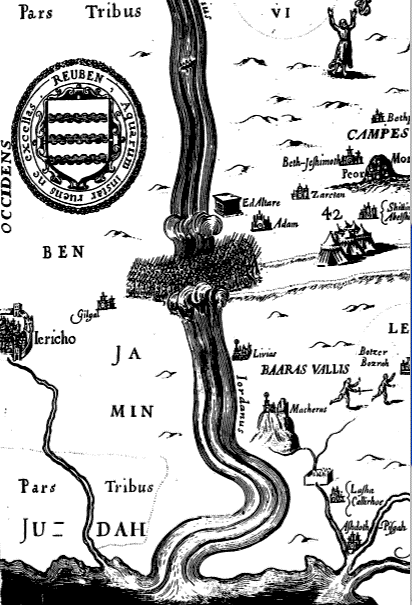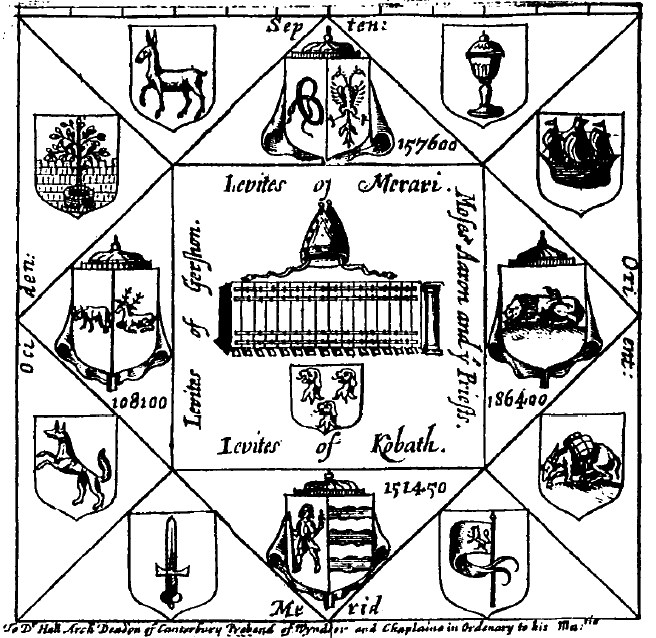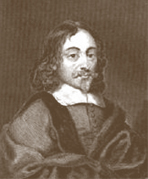Chap. X.
Of the Scutcheons of the Tribes of Israel.
WE will not pass over the Scutcheons of the Tribes of Israel, as they are usually described in the Maps of Canaan and several other pieces, generally conceived to be the proper coats, and distinctive badges of their several Tribes. So Reuben is conceived to bear three Bars wave, Judah a Lyon Rampant, Dan a Serpent nowed, Simeon a sword impale the point erected, &c. The ground whereof is the last Benediction of Jacob,1 wherein he respectively draweth comparisons from things here represented.
Now herein although we allow a considerable measure of truth, yet whether as they are usually described, these were the proper cognizances, and coat-arms of the Tribes; whether in this manner applyed, and upon the grounds presumed material doubts remain.
For first, They are not strictly made out, from the Prophetical blessing of Jacob; for Simeon and Levi have distinct coats, that is, a Sword, and the two Tables, yet are they by Jacob included in one Prophesie, Simeon and Levi are brethren, Instruments of cruelties are in their habitations. So Joseph beareth an Ox, whereof notwithstanding there is no mention in this Prophesie; for therein it is said Joseph is a fruitful bough, even a fruitful bough by a well; by which repetition are intimated the two Tribes descending from him, Ephraim and Manasses; whereof notwithstanding Ephraim only beareth an Ox: True it is, that many years after in the benediction of Moses, it is said, of Joseph,2 His glory is like the firstlings of his Bullock; and so we may concede, what Voßius learnedly declareth, that the Ægyptians represented Joseph, in the Symbole of an Ox; for thereby was best implied the dream of Pharoah, which he interpreted, the benefit by Agriculture, and provident provision of corn which he performed; and therefore did Serapis bear a bushel upon his head.
Again, If we take these two benedictions together, the resemblances are not appropriate, and Moses therein conforms not unto Jacob; for that which in the Prophesie of Jacob is appropriated unto one, is in the blessing of Moses made common unto others. So whereas Judah is compared unto a Lion by Jacob, Judah is Lions whelp, the same is applied unto Dan by Moses, Dan is a Lions whelp, he shall leap from Bashan, and also unto Gad; he dwelleth as a Lion.
Thirdly, If a Lion were the proper coat of Judah, yet were it not probably a Lion Rampant, as it is commonly described, but rather couchant or dormant, as some Heralds and Rabbins do determine; according to the letter of the Text, Recumbens dormisti ut Leo, He couched as a Lion, and as a young Lion, who shall rouse him?
Lastly, when it is said,3 Every man of the Children of Israel shall pitch by his own standard with the Ensign of their fathers house; upon enquiry what these standards and Ensigns were there is no small incertainty; and men conform not unto the Prophesie of Jacob. Christian Expositors are fain herein to rely upon the Rabbins, who notwithstanding are various in their traditions, and confirm not these common descriptions. For as for inferiour ensigns, either of particular bands or houses, they determine nothing at all; and of the four principal or Legionary standards, that is, of Judah, Reuben, Ephraim, and Dan (under every one whereof marched three Tribes) they explain them very variously. Jonathan who compiled the Thargum conceives the colours of these banners to answer the precious stones in the breast-plate, and upon which the names of the Tribes were engraven.4 So the standard for the Camp of Judah, was of three colours, according unto the stones, Chalcedony, Saphir and Sardonix; and therein were expressed the names of the three Tribes, Judah, Isachar, and Zabulon, and in the middest thereof was written,5 Rise up Lord, and let they enemies be scattered, and let them that hate thee flee before thee; in it was also the pourtrait of a Lion. The standard of Reuben was also of three colours, Sardine, Topaz, and Amethyst; therein were expressed the names of Reuben, Simeon, and Gad, in the middest was written,6 Hear, O Israel, The Lord our God, the Lord is one: Therein was also the pourtraiture of a Hart. But Abenezra and others, beside the colours of the field, do set down other charges, in Reubens the form of a man or mandrake, in that of Judah a Lion, in Ephraims an Ox, in Dans the figure of an Eagle.
And thus indeed the four figures in the banners of the principal squadrons of Israel are answerable unto the Cherubins in the vision of Ezekiel;7 every one carrying the form of all these. As for the likeness of their faces, they four had the likeness of the face of a Man, and the face of a Lion on the right side, and they four had the face of an Ox on the left side, they four had also the face of an Eagle. And conformable hereunto the pictures of the Evangelists (whose Gospels are the Christian banners) are set forth with the addition of a man or Angel, an Ox, a Lion, and an Eagle. And these symbolically represent the office of Angels, and Ministers of Gods Will; in whom is required understanding as in a man, courage and vivacity as in the Lion, service and ministerial officiousness, as in the Ox, expedition or celerity of execution, as in the Eagle.[8]
From hence therefore we may observe that these descriptions, the most authentick of any, are neither agreeable unto one another, nor unto the Scutcheons in question. For though they agree in Ephraim and Judah, that is, the Ox and the Lion, yet do they differ in those of Dan, and Reuben, as far as an Eagle is different from a Serpent, and the figure of a Man, Hart, or Mandrake, from three Bars wave. Wherein notwithstanding we rather declare the incertainty of Arms in this particular,[9] than any way question their antiquity; for hereof more ancient examples there are, than the Scutcheons of the Tribes, if Osyris, Mizraim or Jupiter the Just, were the Son of Cham; for of his two Sons, as Diodorus delivereth, the one for his Device gave a Dog, the other a Wolf. And, beside the shield of Achilles, and many ancient Greeks: if we receive the conjecture of Voßius, that the Crow upon Corvinus his head, was but the figure of that Animal upon his helmet, it is an example of Antiquity among the Romans.
But more widely must we walk, if we follow the doctrine of the Cabalists,10 who in each of the four banners inscribe a letter of the Tetragrammaton or quadriliteral name of God: and mysterizing their ensigns, do make the particular ones of the twelve Tribes, accommodable unto the twelve signes in the Zodiack, and twelve moneths in the year: But the Tetrachical or general banners, of Judah, Reuben, Ephraim, and Dan, unto the signs of Aries, Cancer, Libra and Capricornus: that is, the four cardinal parts of the Zodiack, and seasons of the year.
NOTES
*My (or others') notes are in [brackets]; additional material by Browne from manuscripts or previous editions is in {braces}; Browne's original marginalia are not specially marked.
1 Gen. 49. [For instance, on a map in Fuller's A Pisgah-sight of Palestine and the Confines Thereof (1650; insert before page 55), there is the escutcheon of the tribe of Reuben:

2 Deut. 33.
3 Num. 2.
4 The like also P. Fagius upon the Thargum or Chaldie Paraphrase of Onkelus. Num. 2. [See Book II, Chapter V for more on Aaron's Breast-plate.]
5 Num. 10
6 Deut. 6.
7 Ezek. 1.
8 [Wren: The reasons which the fathers give of these emblems is excellent and proper. St. Matthew insists on those prophecyes in Christ, and therefore hath an angel, as itt were, revealing those things to him. St. Marke insists most upon his workes of wonder and miracles, and therefore hathe the lyon of Judah by him. St. Luke is most copious in those storyes which set forthe his passive obedience, and therefore hathe the beast of sacrifice by him. and lastly, St. John, whose gospel sores like the Ægle up to heaven, and expresses the divinity of Christe in such a sublime manner above all the rest, hath therefore that bird set by him. They were shortly, but excellently expresst by these four emblems at the pedestall of prince Henrye's pillar, each of them in a scroll uttering these four wordes, which make up a verse. Expecto, by the angel, impavidus, by the lion, patienter, by the oxe, dum renovabor, by the Ægle. (The column was at the funeral of Henry Prince of Wales.)]
9 [Wilkin: Not a few of our antiquarian writers, theologians, as well as heralds, have been anxious to trace the origin of heraldry to the Bible. Bishop Hall, in his Impresse of God, says, "If the testament of the patriarchs had as much credit as antiquity, all the patriarchs had their armes assigned them by Jacob: Judah a lyon, Dan a serpent, Nephthali an hinde, Benjamin a wolf, Joseph a bough, and so of the rest." Works, fol. 1648, p. 406, E.
In Mr. Jefferson's copy occurs the following MS. note. "Sir John Prestwick, in his MS. history of the noble family of Chichester, derives the practice of heraldry from Gen. i, 14. 'Let them be for signs,' — which he refers to heraldic signs."
Sylvanus Morgan begins with the creation; "deducing from the principles of nature" his Sphere of Gentry, which he divides into four books, the first entitled Adam's shield, or nobility native; the 2nd, Joseph's coat, or nobility dative, etc. In the latter he gives a curiously engraven representation, and a description of Joseph's whole achievement; his coat being per fesse imbatled Argent and Gules out of a Well a Tree growing Proper, ensigned with a Helmet of a Knight thereon, out of a crown Mural Gules, a Wheatsheaf Or; his Mantles being of three sorts: the outmost being that of the gown, being cloth of gold lined with Ermine, Erminees, Erminiois, and Erminets; the next being that of the Cloak, accompanying him in all his adversities, being lined Vaire, Vairy, and Cuppa; the outside Purple; the third being the Mantle for his funeral, being mantled Sable, lined Argent; his Motto, Nec Sorti nec Fato; having his wife's armes in an In-Escutcheon, she being the daughter and heir of Potiphar, Prince and Priest of On; his Sword and Girdle on the left side. Thus he is a publick person, conferring honours by Nobility Dative to his brethren [!!]" — Sphere of Gentry, book ii, p. 72. Alas! for poor Joseph's coat of many colours to be thus blazoned!
Master Morgan, in setting forth the Camp of Israel, seemeth not less exactly informed as to the precise bearing of each tribe.
| JUDAH bare Gules, a lyon couchant or, | East |
| ZABULUN's black Ship's like to a man of warr | |
| ISSACHAR's Asse between two burthens girt, | |
| As DAN's Sly Snake lies in a field of vert. | North |
| ASHUR with azure a Cup of Gold sustains, | |
| And NEPTHALL's Hind trips o'er the flowry plains. | |
| EPHRAIM's strong Ox lyes with the couchant Hart, | West |
| MANASSEH's Tree its branches doth impart. | |
| BENJAMIN's Wolfe in the field gules resides. | |
| REUBEN's field argent and blew Barrs Waved glides. | South |
| SIMEON doth beare the Sword; and in that manner | |
| GAD having pitched his Tent sets up his Banner. |
[Here Wilkin is too arch by half; Morgan gives a source for his information (quaternary, so to speak, as it's a secondary source on Chaldee paraphrase and commentary). He also gives a picture of the layout of the camp, and measurements in the text. Note that the arms as depicted don't necessarily match the verbal description (Reuben has barrs waved all right, but also a man who appears to be playing with a doll, for instance)

but to allow Wilkin to conclude:] Unfortunately, however, as our author shrewdly remarks, the "descriptions" of the cognoscenti are not "agreeable unto one another". Andrew Favine in his Theater of Honor and Knighthood, fol. 1623, p. 4, perfectly agrees with Morgan as to the antiquity of armes and blazons, which he does not hesitate to say "have been in use from the creation of the world." But when he descends to particulars, their disagreement is instantly apparent .... ]
10 Ricius de cœlesti Agricultura. lib. 4.
This page is dedicated to the memory of Boo the Cat.
